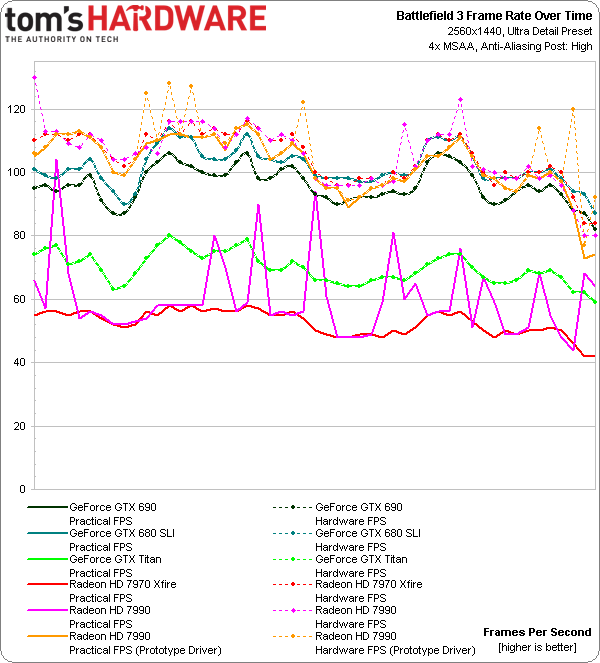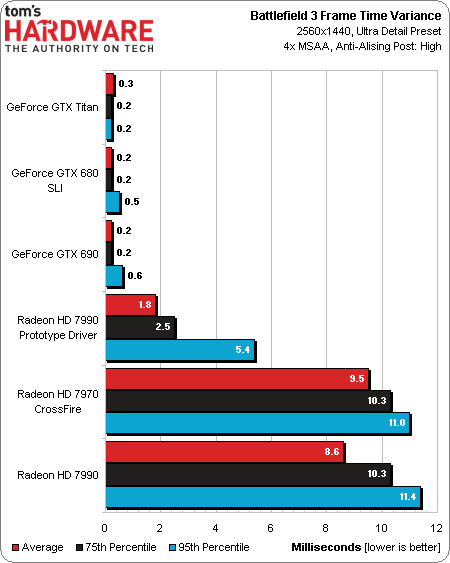AMD Radeon HD 7990: Eight Games And A Beastly Card For $1,000
We've been waiting for this since 2011. AMD is ready to unveil its Radeon HD 7990, featuring a pair of Tahiti graphics processors. Can the dual-slot board capture our hearts with great compute and 3D performance, or does Nvidia walk away with this round?
Results: Battlefield 3
I warned you that there’d be a ton of data to process, and I wasn’t lying. Right out of the gate, allow me to distinguish between the Hardware FPS and Practical FPS numbers in the chart below. Hardware FPS is what we call the result that you would have seen previously, had we stuck to Fraps-based testing. Hardware FPS includes dropped frames and runt frames, neither of which contribute positively to your gaming experience. They do, however, get counted by Fraps.
When we use Nvidia’s overlay tool and process the expected color sequence using FCAT, we’re quickly and accurately able to identify when a frame gets rendered, but never shows up on-screen (a color gets skipped) or when a runt appears (the expected color appears, but occupies 20 vertical scan lines or less, making imperceptible).
The impact of this distinction massively affects AMD’s standing. Allow me to call out specific results. The Radeon HD 7990 appears to serve up more than 100 FPS in Battlefield 3 using Ultra settings at a 2560x1440 resolution. It looks like it’s bumping into a platform limitation on our Core i7-3770K overclocked to 4 GHz, in fact. But when you play back the 90-second video of our benchmark, you clearly see that each visible frame is succeeded by a small runt that only shows up for a millisecond or two. When all of those are factored out, the average frame rate you actually experience is closer to 56.2—lower even than a GeForce GTX Titan. Two Radeon HD 7970s in CrossFire are subject to the exact same issue, yielding confirmation that this isn’t a product-specific phenomenon, but rather a problem that affects AMD’s technology.
Now, you’ll notice that I have data in there corresponding to a prototype driver. Anticipating our findings, the company shipped us an early build of software it plans to make public in the second half of 2013 with provisions for frame pacing. In essence, the driver is adding latency between frames to deliver a more consistent experience, per our hypothetical scenario on the third page of this review. Because the numbers already appeared platform-bound, this doesn’t appear to negatively affect performance, though it almost completely ameliorates the frequency of runts encountered in Catalyst 13.5 Beta 2.
As a point of comparison, the GeForce GTX 680s in SLI, the GTX 690, and GTX Titan all serve up identical hardware and practical frame rate numbers; frame pacing is already something Nvidia enables, so the incidence of dropped and runt frames is very small.
We’re working on the presentation of this data, I promise. For the time being, though, think of the thin, dotted lines as points of reference. They’re the Hardware FPS numbers—the one Fraps would have conveyed. The thicker lines are the practical frame rates over time (in this case, a 90-second run).
For the most part, Radeon HD 7990 tracks with two Radeon HD 7970 GHz Edition cards in CrossFire, except for a number of spikes up closer to the Hardware FPS number. One GeForce GTX Titan appears both faster and smoother in comparison.
Get Tom's Hardware's best news and in-depth reviews, straight to your inbox.
There’s hope for AMD, though. See the prototype driver’s practical frame rate hovering up alongside two GeForce GTX 680s in SLI?
By pacing out its frames at a largely platform-bound resolution, the three GeForce-based configurations present minimal frame time variation. In comparison, the Radeon cards driven by Catalyst 13.5 Beta 2 demonstrate more variation between frames.
In the past, we would have looked at 95th percentile numbers in the 11 ms range and suggested that the real-world impact of that variation would be minimal. However, after polling gamers who swapped between HD 7990- and GTX 690-powered PCs, all of which could tell the difference, we’re forced to question what is and is not perceptible latency.



